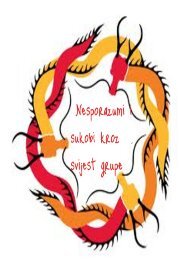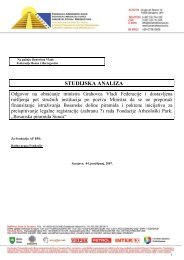The Complete Guide To Mysterious Beings - Galaksija
The Complete Guide To Mysterious Beings - Galaksija
The Complete Guide To Mysterious Beings - Galaksija
Create successful ePaper yourself
Turn your PDF publications into a flip-book with our unique Google optimized e-Paper software.
nearby buildings, pursuing insects. <strong>The</strong>ir wavering tails are tipped with a poisonous barb that<br />
paralyzes their prey. <strong>The</strong>ir sting has been known to kill men. In the little village of Abu Rawash, not<br />
far from the Great Pyramid of Gizah, we met a family of snake hunters who were so adept at<br />
handling these loathsome creatures that they even put scorpions on their faces and let them crawl<br />
around while we took pictures.<br />
When you travel through scorpion country it becomes a habit to shake out your shoes every<br />
morning in case one of the little monsters has staked out a claim in the toe and is lying in wait to<br />
give you a new kind of hotfoot.<br />
Fossils and other evidence dating back 350 million years indicate that giant scorpions or euripterids<br />
ranging from five to nine feet long were once plentiful on this planet. Maybe they were the source<br />
of the ”racial memory” which still haunts us.<br />
<strong>The</strong>re are spiders on this planet so big that they prey upon birds and snakes. While boa constrictors<br />
crush all the bones of their victims before swallowing them whole, spiders discharge a very potent<br />
fluid over their trapped prey. This fluid liquifies the victim, for spiders cannot eat solid food.<br />
Lizards, snakes, and fish have been killed by giant spiders and liquified in a matter of hours.<br />
Nature works in complex ways. All kinds of animals and insects have developed weird and even<br />
ridiculous digestive systems. We have sponges that pump water through their cells to extract<br />
whatever food particles might exist. <strong>The</strong>re are fish that climb trees, snakes that can glide, birds that<br />
can't fly, bats that can't land, microscopic forms of life that live on stone and even lead.<br />
We have trees and plants that feast upon insects and living things. <strong>The</strong>re are even animals that are<br />
cunningly disguised as plants, such as crinoids: brilliantly colored things with featherlike arms<br />
which can exude a paralyzing poison. Not so long ago there were myths of a man-eating plant on<br />
Madagascar but these eventually proved to be without foundation.<br />
<strong>The</strong> famous Venus's-flytrap, a bug-consuming plant, has been found growing naturally in only one<br />
spot on the earth. That spot is an ancient meteor crater in North Carolina. Colonial Governor Arthur<br />
Dobbs discovered the flytrap in 1760, and there has been much speculation since then that the plant<br />
was somehow introduced to our world by a crashing meteor.<br />
When we try to assess these wonders, we are forced to ask ourselves how many other marvels may<br />
exist with us without our knowledge? <strong>The</strong> gorilla was considered a mere myth for many years, as<br />
was the okapi, a crazy combination of horse and zebra which was first captured in Africa in the<br />
early 1900s. A ferocious giant lizard, the Komodo dragon, remained folklore until the 1930s when<br />
an American expedition visited Indonesia and brought one back alive.<br />
A world that can produce vampire bats, flying snakes, and nine-foot scorpions might well be able to<br />
serve as the nesting place for fifteen-foot-tall apes and giant birds. <strong>The</strong> Abominable Snowman is no<br />
more impossible than a fifteen-foot-tall penguin and, believe it or not, there is some evidence (but<br />
not much – see Chapter 5) that such a breed of penguins exists. <strong>The</strong>re is also considerable evidence,<br />
which we will review later on, that ten-foot-tall giant men once roamed this little mudball of ours.<br />
<strong>The</strong> Type B scientists sit in their campus ivory towers and scoff while men like Dr. Ditmars poke<br />
around inhospitable jungles and caves reeking with bat guano. In any given year the back pages of<br />
your own local newspaper carries dozens of small ”human interest” items about new sightings of<br />
sea serpents, ABSMs, and the funny folk who ride around in flying saucers. Are all these things<br />
journalistic put-ons? Are we still wallowing in the myths and nonsense of the Middle Ages?










